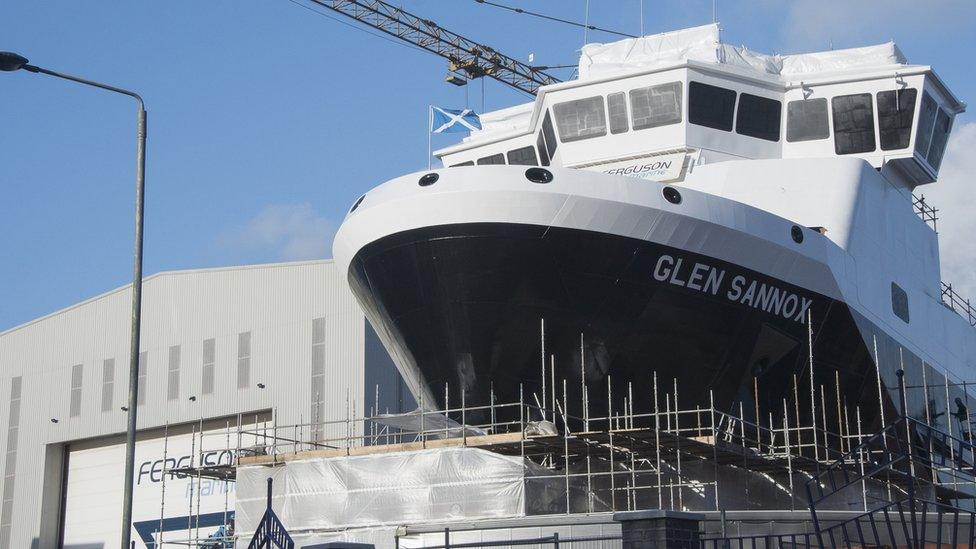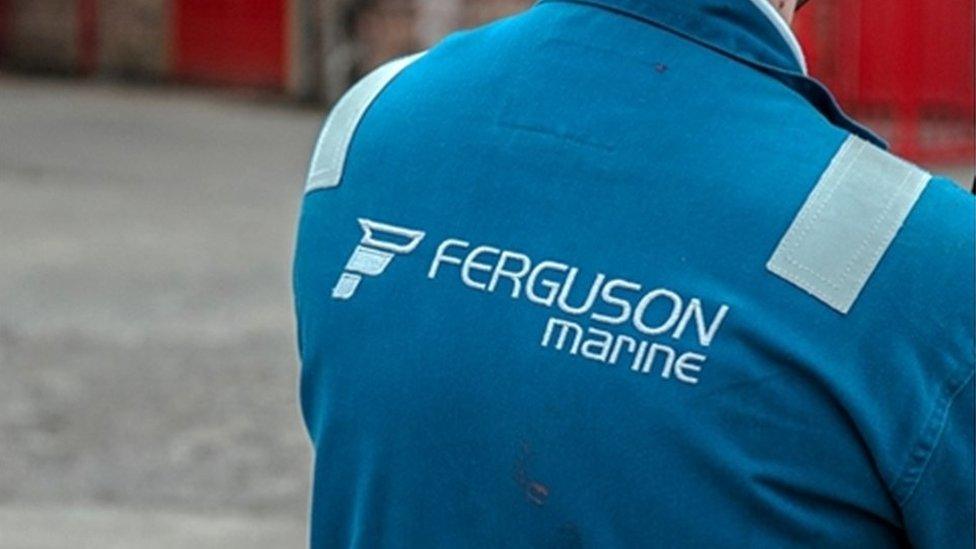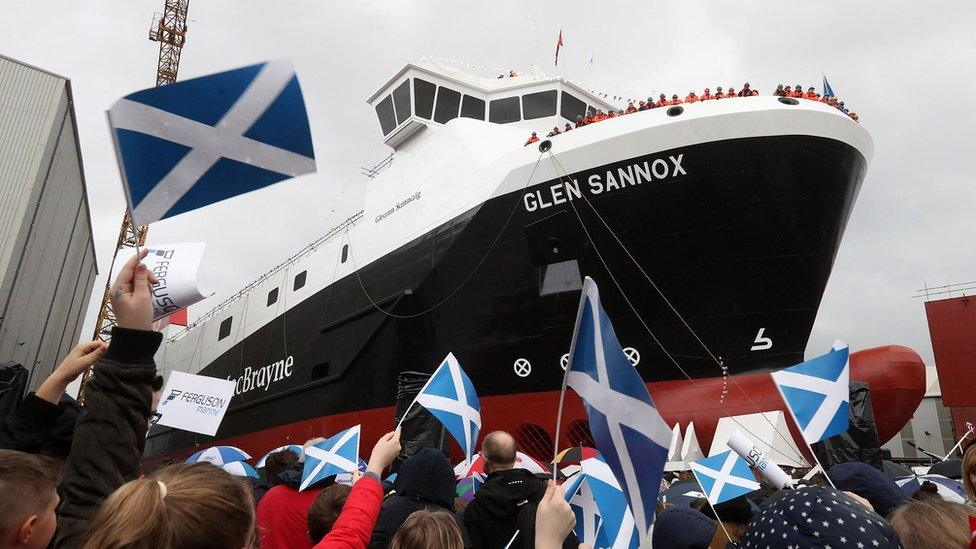The lifeline ferry deal that went adrift
- Published

When Ferguson Shipbuilders went bust in the summer of 2014 it seemed the last shipyard on the lower Clyde was heading for oblivion, more than a century after it was founded by the four Ferguson brothers.
But within weeks, in a deal brokered by then First Minister Alex Salmond, a white knight stepped forward in the shape of Jim McColl.
A self-made billionaire, he was one of the most prominent business figures to support Scottish independence ahead of the referendum in September that year.

Jim McColl stepped in to rescue the shipyard in 2014
McColl, who made his fortune transforming the ailing Clyde Blowers into a portfolio of engineering investment companies, was adamant that Scottish shipbuilding could have a bright future.
Investment swiftly followed - the old buildings were demolished and replaced by state-of-the-art fabrication and design facilities.
The workforce at Ferguson Marine Engineering Ltd (FMEL) as it became known, rose from about 70 to 350, including apprenticeships in one of the most socially deprived areas of Scotland.

The workforce at Ferguson Marine rose five-fold after its takeover by Jim McColl
The new owner had plenty of ideas for the yard's future - refitting superyachts, fishing vessels, a new generation of hydrogen-powered ships.
Ferguson was also part of the consortium which was eventually named preferred bidder to build the Royal Navy's new Type 31e frigates.
Early work, however, came in the shape of orders for Scotland's publicly-owned ferry firm Caldedonian MacBrayne.
When McColl took over the yard it already had an order for a small diesel/electric hybrid ferry to keep it going - but in 2015 it received a major boost when it won a £97m order for two much larger ships.
Ironically this apparent lifeline was to have catastrophic consequences for the shipyard, eventually plunging it back into administration.

Early fabrication work on Glen Sannox which is still not ready seven years since the award of the contract
The ferries were to be a hybrid design, powered by marine diesel oil and liquefied natural gas - not a particularly new technology in worldwide terms but a first for a UK shipyard.
The hull of the first ship - Glen Sannox - soon started taking shape - but behind the scenes something was going badly wrong.
The yard was undergoing major redevelopment, and the original plan to build the two ships concurrently soon foundered.
Glen Sannox - destined for the Arran route - came off the slipway in November 2017 at a launch attended by First Minister Nicola Sturgeon.
But the ship was far from finished. Despite the fanfare the more eagle-eyed among the cheering crowds might have noticed that the windows of the bridge were filled not with glass but painted boards.
The ship was expected to enter service in mid-2018 but more than four years after its launch it remains moored beside the yard while work continues.
The second ferry, currently known as hull 802, earmarked for the Skye, Harris and North Uist route, is still being constructed and won't be ready until summer 2023 at the earliest.
The cost of the work has risen to about £240m, more than double the original fixed price cost, and despite some controversial loans totalling £45m from the Scottish government the shipyard went bust in the summer of 2019.
Scottish ministers had been unwilling to stump up more cash, arguing to do so would break state aid rules.
Instead they ended up nationalising the yard, safeguarding jobs - but landing the public purse with a bill in excess of £100m to finish the ships.
Blame game
There's been a lot of finger pointing. Jim McColl has repeatedly laid the blame for the problems at the door of CMAL- the company that owns and manages ferries and other assets on behalf of the Scottish government.
In a BBC interview he accused CMAL of making repeated specification changes - a claim denied by CMAL. The hybrid propulsion design also required lengthy certification processes from insurers and regulators, he said.
In its accounts his company FMEL blamed unforeseen costs on "post contract award, variations, interference, and disruption caused by the customer".
But that customer, CMAL, painted a different picture, accusing FMEL of rushing ahead with construction before completing the design work and getting the blueprints signed off.
After ministers took over the yard, a government report, external blamed poor project management while McColl's firm was in charge and a lack of financial controls.

Glen Sannox was launched in November 2017 - but there was still no glass in the windows
McColl hit back, again insisting the fault lay chiefly with CMAL and suggesting it would have been cheaper to scrap the ferries and start again with a simpler design.
Last year a damning report from a cross-party committee of MSP branded the whole affair a "catastrophic failure".
All of the main protagonists, it said - FMEL, CMAL, Transport Scotland, government ministers - must take some responsibility for what went wrong.
A recent report from Audit Scotland also found multiple failings - but said one key mistake was the government's awarding of the contract to Ferguson, against the advice of CMAL, despite it being unable to provide normal refund guarantees should something go wrong.
Nicola Sturgeon has indicated that decision was taken by former transport minister Derek Mackay - who later resigned from government amid a scandal over social media messages to a teenage boy. But the first minister says there was collective responsibility and "the buck stops with me".
The only group consistently absolved of blame are the workers at Ferguson shipyard itself whose morale has been sorely tested by the saga. One of them recently told his local MSP he was embarrassed to work at the yard.
The latest bill for the ships is more than £250m, and they are now due to be delivered five years late in 2023 - provided more problems aren't encountered.
The ferry deal was meant to provide a lifeline to a once proud workforce, but it ended up dragging down the Clyde's last commercial shipyard - and the saga isn't over yet.
Related topics
- Published19 July 2019
